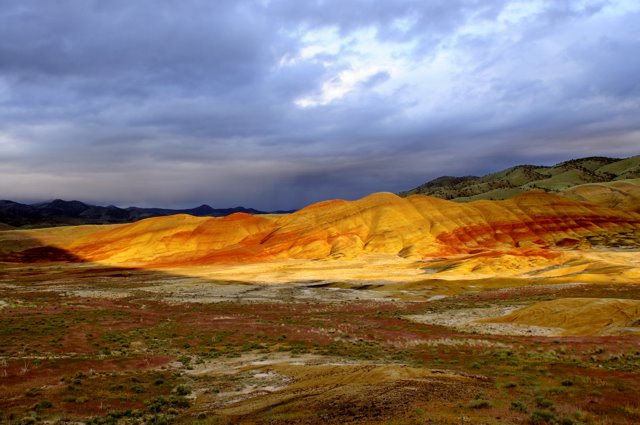The weather finally broke a little bit and I was able to get out and shoot a few pictures this morning. It was cloudy and the wind had a nasty bite but at least it wasn't snowing or raining.
My objective was to attempt to photograph a Red Fox that has been seen recently near where we are staying. I didn't know for sure if I would be successful with this and had a back up plan of photographing the fox's food. Golden Marmots live on the same hillside as the Fox and in great profusion. These can be interesting and challenging too. You can hear them chirping before you will ever see them. This fox is well known by the community and we all look forward to seeing it and it's kit's in the Spring.
A long range lens is very helpful in this kind of work photography and I have a Sigma 170-500 that I use. It's not top of the line but it does a good job in good light. This is the lens I would use for this project.
During a two or three hour I was able to capture a few scenes of snow capped mountains, marmots, two foxes, and a barn owl. The owl shots didn't turn out with this lens as it was flying and I was on a tripod set up for sleeping foxes when it came by.
I didn't get any really great shots of anything but that's not the point. The point is that I was able to get out there and get something. It was a good day!
Thursday, May 6, 2010
Subscribe to:
Post Comments (Atom)
Photography Tips
Here are a few things you can do to improve your photography that will apply regardless of what camera you use. These are the basics that every photographer should know and do to get reasonably good pictures out of any camera.
Make sure you have a clean lens. Don't just blow the dust off, but use a clean cloth suitable for cleaning lenses and do it right.
Set up so your camera is stable and won't move as you press the shutter. You can do this a number of ways. If you will be handholding the camera, hold your elbows in against your sides, and stand with your feet apart with one slightly forward of the other. You can also lean against a solid object like a light pole, tree, building or whatever. The best method though is to use a tripod or monopod. I have both but I like to carry the tripod best. If I want to use it as a monopod I just extend only one leg and us it as I would a monopod. I'll add instructions about to how to use these tools later.
Finally the "First" basic thing you need to do is read your manual and learn what all the parts of your camera are for and how to use them. If you understand how your meter works and what white balence is you'll go a long way to getting that shot you want when the light is wierd and you are wondering why your pictures are all dark or yellow instead of like what you saw on the monitor or in the viewfinder.
I'll expand on all these topics in the coming weeks and months so you'll want to check back and see what I've added from time to time.
Make sure you have a clean lens. Don't just blow the dust off, but use a clean cloth suitable for cleaning lenses and do it right.
Set up so your camera is stable and won't move as you press the shutter. You can do this a number of ways. If you will be handholding the camera, hold your elbows in against your sides, and stand with your feet apart with one slightly forward of the other. You can also lean against a solid object like a light pole, tree, building or whatever. The best method though is to use a tripod or monopod. I have both but I like to carry the tripod best. If I want to use it as a monopod I just extend only one leg and us it as I would a monopod. I'll add instructions about to how to use these tools later.
Finally the "First" basic thing you need to do is read your manual and learn what all the parts of your camera are for and how to use them. If you understand how your meter works and what white balence is you'll go a long way to getting that shot you want when the light is wierd and you are wondering why your pictures are all dark or yellow instead of like what you saw on the monitor or in the viewfinder.
I'll expand on all these topics in the coming weeks and months so you'll want to check back and see what I've added from time to time.

No comments:
Post a Comment